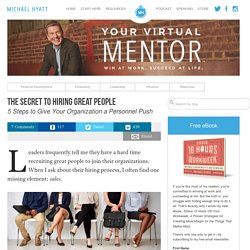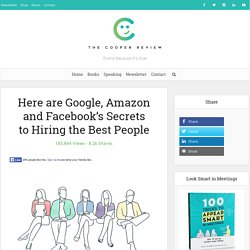

Hiring for Culture Fit Doesn’t Have to Undermine Diversity. Executive Summary The idea of hiring for culture fit has become controversial.

But research suggests it need not be. Most of the controversy boils down to a single key issue: the wrong definition of culture fit. This has given rise to a number of common misconceptions about how culture fit affects diversity and innovation. Clearing these up can help managers measure culture fit correctly and improve their talent strategies. Although most managers would agree that it is important to hire people who fit in, the idea of hiring for culture fit has become controversial.
Misconception #1: Culture fit is a “nice to have” but not a necessity. The core assumption here is that employees’ skills and competences matter more for organizational effectiveness than how well they fit in. Misconception #2: Hiring for culture fit hurts diversity. Work Principle 8; Hire right because the penalties for hiring wrong are huge. Grow Someone Past You. The Secret to Hiring Great People. Leaders frequently tell me they have a hard time recruiting great people to join their organizations.

When I ask about their hiring process, I often find one missing element: sales. Recruiting great people is similar to any kind of sales process. Your company is the product. Prospective employees are your customers. The recruiting process is not just about filtering candidates—it’s also your sales pitch. What if there were a tool to keep your goals top of mind and keep you focused on the critical next steps to accomplish them? Over the years, my team and I have found it’s much easier to attract the right people if we approach hiring as a sales campaign. In fact, we just brought aboard two highly talented players this month with this model. Step 1: Create the Product It is much easier to close a deal if you have a great product to sell.
Identify why people should want to work for your organization. Do you offer generous time off? Step 2: Build a Landing Page Step 3: Solicit Testimonials.
Shared Values. Here are the Top Tech Companies’ Secrets to Hiring the Best People – The Cooper Review – Medium. Google, Facebook, Apple, Amazon, Google, Amazon.

These top tech companies each receive over a quadrillion resumes per year (source needed). So it’s safe to say they have a good process for choosing the best job candidates. But what is it? No, it’s not that list of popular Google interview questions you Googled on Google. In fact, their finely tuned hiring process goes way beyond rudimentary queries on algorithms and quantum physics. If you, too, want to hire the world’s best top tech talent, try one of these secret hiring strategies. Begin phone screens 15 minutes early, 15 minutes late, or not at all To find people who are always ready for the job Anyone can answer a series of probing questions when you call them at the expected time. Make the interview schedule as confusing and unpredictable as possible To find people who don’t need instructions Make sure that neither the interviewers or interviewees have any idea what’s going to happen during the interview.
Here's Google's Secret to Hiring the Best People. “You never get a second chance to make a first impression” was the tagline for a Head & Shoulders shampoo ad campaign in the 1980s. It unfortunately encapsulates how most interviews work. There have been volumes written about how “the first five minutes” of an interview are what really matter, describing how interviewers make initial assessments and spend the rest of the interview working to confirm those assessments. If they like you, they look for reasons to like you more. If they don’t like your handshake or the awkward introduction, then the interview is essentially over because they spend the rest of the meeting looking for reasons to reject you. These small moments of observation that are then used to make bigger decisions are called “thin slices.” The problem is, these predictions from the first 10 seconds are useless. They create a situation where an interview is spent trying to confirm what we think of someone, rather than truly assessing them.
Click to Open Overlay Gallery.